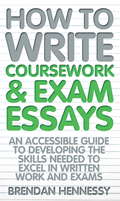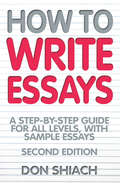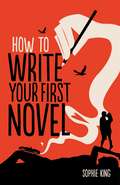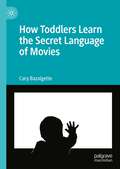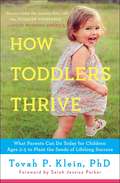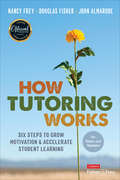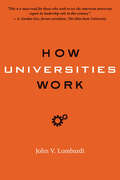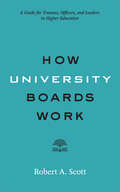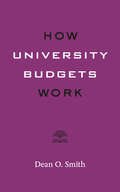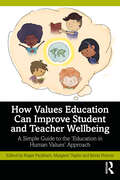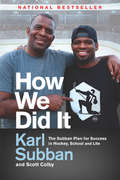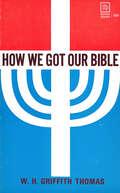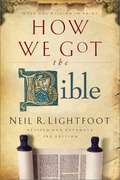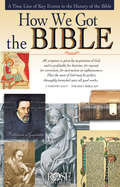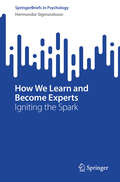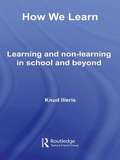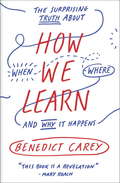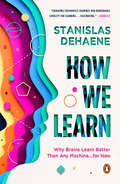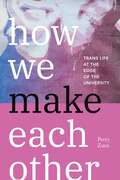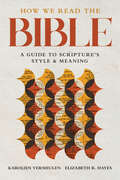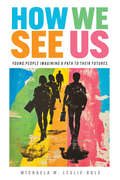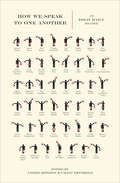- Table View
- List View
How To Write Coursework and Exam Essays: An Accessible Guide To Developing The Skills Needed To Excel In Written Work And Exams
by Brendan HennessyWriting good essays is a vital study skill for all stages of education, from GCSE to degree level. This highly successful and thoroughly practical guide leads you step-by-step through the whole process, including: *How to put your ideas into shape * Making your essay coherent and giving it conviction *How to think straight and argue well *How to write a good introduction and conclusion *Improving your style *Editing and rewriting. Now in its 6th edition this book has been thoroughly revised and updated to take account of feedback from teachers and students, incluyding the reqirements of online research. Use the techniques and exercises in this book to develop the originality and good writing that examiners look for - and write essays of distinction every time.
How To Write Essays: A Step-by-Step Guide for All Levels, With Sample Essays
by Don ShiachThe skill of good essay writing is essential if you are to achieve the kind of grades you want in the courses you are studying. This is true whether you are studying at GCSE, AS or A levels at school or college, or trying to gain a degree at university. The advice and practical guidance you receive in this book will enable you to improve your grade assessments by putting into practice some simple, but invaluable principles of essay writing. These approaches will work for you whether you are facing assessment in timed exam conditions or being judged by coursework assignments. This book will take you step by step from your opening to your closing paragraph, so that you focus your thoughts on answering the assignment appropriately and relevantly. It also contains ten sample essays and useful chapters on grammar, accuracy and spelling.
How To Write Essays: A Step-by-step Guide For All Levels, With Sample Essays
by Don ShiachThe skill of good essay writing is essential if you are to achieve the kind of grades you want in the courses you are studying. This is true whether you are studying at GCSE, AS or A levels at school or college, or trying to gain a degree at university. The advice and practical guidance you receive in this book will enable you to improve your grade assessments by putting into practice some simple, but invaluable principles of essay writing. These approaches will work for you whether you are facing assessment in timed exam conditions or being judged by coursework assignments. This book will take you step by step from your opening to your closing paragraph, so that you focus your thoughts on answering the assignment appropriately and relevantly. It also contains ten sample essays and useful chapters on grammar, accuracy and spelling.
How To Write Your First Novel
by Sophie KingLet best-selling novelist Sophie King guide you through the whole process of writing your first novel and getting it published.This revised edition takes aspiring novelists through the steps of writing a novel, from finding that initial idea, to keeping the plot going and crafting the perfect ending. With helpful exercises in each chapter you will learn how to:- Develop a brilliant idea for your first novel - Create characters that will make your novel come alive - Plot your novel so that your readers simply have to turn the page - Unravel the mysteries of viewpoint - Create realistic dialogue and settings so your readers feel they are there - Find your own voice. - Most importantly, the book includes tips and advice on how to get published. This new edition also includes a ten step guide to revision so that you can polish your novel to be the best it can be.
How Toddlers Learn the Secret Language of Movies
by Cary BazalgetteThis book takes a radically new approach to the well-worn topic of children's relationship with the media, avoiding the "risks and benefits" paradigm while examining very young children's interactions with film and television. Bazalgette proposes a refocus on the learning processes that children must go through in order to understand what they are watching on televisions, phones, or iPads. To demonstrate this, she offers unique insight from research done with her twin grandchildren starting from just before they were two years old, with analysis drawn from the field of embodied cognition to help identify minute behaviours and expressions as signals of emotions and thought processes. The book makes the case that all inquiry into early childhood movie-viewing should be based on the premise that learning–usually self-driven–is taking place throughout.
How Toddlers Thrive: What Parents Can Do Today for Children Ages 2-5 to Plant the Seeds of Lifelong Success
by Tovah P KleinFrom child development psychologist and parenting expert Dr. Tovah Klein—called &“the toddler whisperer&” by Good Morning America—comes a lively and revelatory book that will teach parents of children ages two to five how to harness the singular power of the toddler mind, plant the seeds of lifelong success, and lessen struggles around bedtime, eating, tantrums, and more.Why do some children thrive, and others struggle? The answers may surprise you. New research indicates that the seeds for adult success are actually planted in the toddler years. Dr. Tovah Klein’s research and firsthand work with thousands of toddlers explains why the toddler brain is best suited to laying the foundation for success. Dr. Klein reveals the new science behind drivers such as resilience, self-reliance, self-regulation, and empathy that are more critical to success than simple intelligence. She explains what you can do today to instill these key qualities in your toddler during this crucial time, so they are on track and ready to learn when they enter school at age five. How Toddlers Thrive explains why the toddler years are different than any other period during childhood. She shows what is happening in children’s brains and bodies at this age that makes their behavior so turbulent, and why your reaction to their behavior—the way you speak to, speak about, and act toward your toddler—holds the key to a successful tomorrow and a happier today. This provocative book will inspire you to be a better parent, and give you the tools to help you nurture your child’s full potential. A smart and useful guide, this book cracks the preschooler code, revealing what you can do to help your toddler grow into a fulfilled child and adult—while helping you and your toddler live more happily together now, and every day.
How Tutoring Works: Six Steps to Grow Motivation and Accelerate Student Learning
by Douglas Fisher Nancy Frey John T. AlmarodeBuild students’ confidence and competence with tutoring strategies that spark meaningful, accelerated learning. Tutoring is much more than telling students information. Effective tutoring begins with the strong and caring relationship a tutor establishes with a learner to build trust, fuel motivation, and drive critical learning. How Tutoring Works distills the complexity of strategic moves effective tutors make to build students’ confidence and competence. Harnessing decades of Visible Learning® research, this easy to read, eye-opening guide details the six essential components of any effective tutoring intervention—establishing a relationship and credibility, addressing student confidence and challenges, setting shared goals, helping a student learn how to learn, teaching and learning content, and establishing a habit of deliberate practice. Indispensable for any educator who intervenes with students, this rich resource includes: Examples of impactful tutoring conversations, including what to say and what not to say when building a relationship with a learner. Specific approaches to use when establishing credibility, addressing challenges to learning, leveraging the relevance of knowledge, setting goals, and ensuring practice. Learning strategies, with effect size, for teaching and learning content, including specific strategies for improving reading, writing, and mathematics. Tips and tools for helping students develop powerful cognitive, metacognitive, and affective study skills. Resources and advice for establishing an effective and transformational tutoring program. Done well, tutoring can repair a student’s damaged relationship to learning, address unrealized potential, and alter the course of a young person’s life. A strong and nurturing relationship between tutor and learner is key.
How Tutoring Works: Six Steps to Grow Motivation and Accelerate Student Learning
by Douglas Fisher Nancy Frey John T. AlmarodeBuild students’ confidence and competence with tutoring strategies that spark meaningful, accelerated learning. Tutoring is much more than telling students information. Effective tutoring begins with the strong and caring relationship a tutor establishes with a learner to build trust, fuel motivation, and drive critical learning. How Tutoring Works distills the complexity of strategic moves effective tutors make to build students’ confidence and competence. Harnessing decades of Visible Learning® research, this easy to read, eye-opening guide details the six essential components of any effective tutoring intervention—establishing a relationship and credibility, addressing student confidence and challenges, setting shared goals, helping a student learn how to learn, teaching and learning content, and establishing a habit of deliberate practice. Indispensable for any educator who intervenes with students, this rich resource includes: Examples of impactful tutoring conversations, including what to say and what not to say when building a relationship with a learner. Specific approaches to use when establishing credibility, addressing challenges to learning, leveraging the relevance of knowledge, setting goals, and ensuring practice. Learning strategies, with effect size, for teaching and learning content, including specific strategies for improving reading, writing, and mathematics. Tips and tools for helping students develop powerful cognitive, metacognitive, and affective study skills. Resources and advice for establishing an effective and transformational tutoring program. Done well, tutoring can repair a student’s damaged relationship to learning, address unrealized potential, and alter the course of a young person’s life. A strong and nurturing relationship between tutor and learner is key.
How Universities Work (Higher Ed Leadership Essentials)
by John V. LombardiThe single best description of the inside workings of contemporary universities.Witty and insightful, How Universities Work is destined to be an essential handbook for anyone wanting to understand universities in the United States. John V. Lombardi gives readers an insider’s view of the academy, describing the structure, logic, dynamics, and operational styles of both public and private institutions of higher education. Lombardi defines and describes all the bits and pieces that compose a university with remarkable economy—from budgeting systems to tenure, from the library to the athletic field. Although focused on research universities, much of the discussion applies to other types of post-secondary institutions. Ideal for students, this book will form a solid foundation for courses in higher education, but it will also be a welcome addition to faculty and administrators’ personal libraries.
How University Boards Work: A Guide for Trustees, Officers, and Leaders in Higher Education (Higher Ed Leadership Essentials)
by Robert A. ScottAn expert guide designed to help university trustees become effective leaders.Honorable Mention for Eric Hoffer Award (Business Category) by The Hoffer ProjectWe expect college and university trustees to hire the president, advise senior staff, manage investments and financial decisions, and oversee major strategic initiatives. Unfortunately, they sometimes come into this powerful role with little or no understanding of what they are meant to do or how their institutions work.How University Boards Work, by Robert A. Scott, is designed to help trustees understand how to fulfill their responsibilities. Written by a widely respected leader in American higher education and former university president, How University Boards Work is the product of personal experience and considerable research. This concise, straightforward guide includes:• an explanation of the difference between governance and management• tips on how best to prepare for board decisions and discussions• examples of positive and negative board behavior• guidance about board professional development• advice on managing transitions between chief executivesHow University Boards Work will prove an invaluable resource for those responsible for governing colleges and universities, whether privately financed or state funded. It will also be an illuminating read for board secretaries, campus executives and administrators, faculty leaders, alumni volunteers, and public officials, as well as anybody seeking to understand institutional governance in the light of past and current trends in higher education.
How University Budgets Work (Higher Ed Leadership Essentials)
by Dean O. SmithAn accessible handbook for anyone who needs to understand a university budget—perfect for the non-finance higher ed professional.To understand how universities function, it is critical to understand how their budgets work. In this useful volume, Dean O. Smith provides a concise explanation of university budgets—why they're important, how they are prepared, what information they provide, and how they are monitored.Translating technical jargon into layman's terms, How University Budgets Work emphasizes practical matters and best practices. Writing for a non-specialist audience, Smith covers major aspects of university budgets ranging from their preparation and alignment with strategic plans to their implementation at the departmental level. Offering time-tested advice from his many years in higher administration, he also touches on • expenditure monitoring• projections• allocations• revenue• incentives • financial reserves• end-of-year accounting The companion book to the more rigorous University Finances, also by Smith, How University Budgets Work is a unique introductory guide for the extended academic community. Ultimately, this logical, accessible book provides a working knowledge of how university budgets are produced and implemented, one that enables faculty members and administrators to become more effective in their roles within the university.
How Values Education Can Improve Student and Teacher Wellbeing: A Simple Guide to the ‘Education in Human Values’ Approach
by Margaret Taplin Roger Packham Kevin FrancisPresenting Values Education as a solution to major challenges in education such as student disengagement and teacher burnout, this book provides a wealth of practical advice about how to implement the Education in Human Values approach in schools, promoting wellness and improved educational outcomes.Values Education is a world-wide movement and comes in several forms. This book explains the need for and nature of values education, provides practical, easy strategies for implementing the Education in Human Values (EHV) approach, and outlines the educational theories that underpin it. The practical strategies in this book can be implemented in small increments in all aspects of school life. The focus is on both student and teacher wellbeing. The methods can also be used by teachers to address their own professional and personal challenges and to help them cope with difficult situations that cannot be changed.Written for teachers, teacher educators, and teachers in training, this book is the one-stop-shop for gaining a better understanding of values education, how it can support whole-school wellbeing and how to implement it effectively.
How We Did It: The Subban Plan for Success in Hockey, School and Life
by Karl Subban Scott ColbyThe ultimate hockey dad, Karl Subban is a former school principal and father of five, including three sons--P.K., Malcolm and Jordan--who have been drafted to the NHL. Karl's inspirational and moving story follows the hockey journey from house league to the big leagues and shows how to grow the unlimited potential that is in every child.In his thirty-plus years of coaching, teaching and parenting, Karl Subban has proved to be a leader with the gift of inspiring others. He has dedicated his life to helping young people grow their potential--to be better at what they do, and to be better people. Originally from Jamaica, Karl Subban, along with his wife, Maria, have raised five accomplished children. Their oldest son is P.K. Subban, who won the Norris trophy for top defenceman in the NHL and whose trade from the Canadiens to the Nashville Predators shocked the hockey world. Their two daughters are teachers, one a university basketball star and the other a talented visual artist. Their two youngest sons, Malcolm and Jordan, have been drafted and signed by the Bruins and the Canucks. As a child, Karl dreamed of being a star cricket player--but when he moved to Canada at age 12, hockey and basketball became his new passions. At university, when he realized his NBA hoop dreams would not come to be, Subban found his true destiny as an educator, devoting his life to bringing out the best in his students and his children. From the backyard hockey rink to the nail-biting suspense of draft days, Karl Subban shares tales of his family's unique hockey journey. Mixing personal stories with lessons he learned as a coach and principal--lessons about goal-setting, perseverance and accomplishment--How We Did It will allow other parents, teachers, coaches and mentors to apply the same principles as they help the young people in their lives to identify, develop and live their dreams.
How We Got Our Bible
by W Griffith ThomasIs the Bible God's Word? Or does it contain God's Word? How much of it is accurate? Can it be trusted? How can one be sure? Who decided which books were to be included? What about the books which were left out? How have archaeological discoveries affected the Bible? These forthright questions—and scores more—are clearly and concisely answered in How We Got Our Bible.W. Graham Scroggie has said that "the reading of Dr. Thomas' books creates in one a deeper love of and desire for God as revealed in His Word," and this is strikingly ture of this clear and satisfiying marshaling of evidence as to what the Bible is.In twelve fact-packed chapters, Dr. Thomas ably discusses the structure and history, canonicity, authority, trustworthiness, unity, progressiveness, inspiration, interpretation and purpose of the Bible. Questions conclude each chapter, giving How We Got Our Bible a wide range of usefulness.
How We Got the Bible (Third Edition, Revised and Expanded)
by Neil R. LightfootHow and when did the books of the Bible originate? In what sense are these books different from other books? How have these books been preserved and transmitted to us? Why do we have so many different translations of the Bible? How We Got the Bible provides factual, accessible answers to questions like these. A classic guide for Bible students, it has sold more than 300,000 copies during its forty years in print. Now, in this new edition, each chapter has been revised and chapters have been added, including two on the Septuagint and the Latin Vulgate. This thorough revision will tempt fans of the previous edition and pave the way for a new generation of readers as well.
How We Got the Bible: A Time Line Of Key Events In The History Of The Bible (How We Got The Bible Ser.)
by Rose PublishingThe How We Got the Bible ebook will increase the confidence of every believer regarding the reliability of the Bible. The bestselling ebook includes a time line of key events in Bible-making history, examples and illustrations of ancient writing materials, and a variety of Bible versions. This full-color ebook includes the inspiring stories of early translators who gave their lives to translate and print the Bible, including William Tyndale, John Wycliffe, King James, Erasmus, and Johann Gutenberg. Few stories in the history of the world are as amazing and as touching as the story of how we got the Bible. This stunning pamphlet takes readers through this historical story and a time line of faithfulness, courage, and sacrifice for the sake of making the Bible available to us today. How We Got the Bible provides: •Ten key points on how we got the Bible •Illustrations of ancient documents created on papyrus and fine animal skins, as well as the first printing press •A time line that follows the emergence of the Scriptures that begins in 2000 BC and each major step taken in Bible publishing through AD 2000 How We Got the Bible is an amazing ebook that will encourage every believer, and that answer the questions of those still seeking. The ebook reveals how the Old and New Testaments were communicated through a variety of forms beginning as early as 1500 BC when they were written on stone, clay and leather, and later on papyrus, and fine animal skins. Discover the reasons we can trust the reliability of the Bible, for example, how earliest Bible manuscripts were intricately copied by hand and how ancient texts, such as the Dead Sea Scrolls, validate the earliest manuscripts. A time line in the ebook displays the remarkable and fascinating history of the Bible beginning in 2000 BC with Old Testament writers. The time-line captures key moments in Bible-making history such as: •The translation of the Septuagint, the Hebrew Old Testament translated into Greek in 500 BC •The collection of the 27 Books of the New Testament and formal confirmation of the Canon in AD 300 •The first English translation of the Bible by John Wycliffe in 1300 •The King James Version of the Bible written in 1611 •The discovery of the Dead Sea Scrolls in 1947 •The creation of dozens of modern versions of the Bible through 2008 How We Got the Bible ebook reveals the people that were key to Bible translation history, including: Erasmus, Martin Luther, William Tyndale, Miles Coverdale, and many others.Topical index: Apocrypha, Augustine, Bible translations, church fathers, codex, Dead Sea Scrolls, earliest translation, earliest translations, first book printed, first English Bible, Gutenberg, Hebrew Scriptures, Jewish tradition, Martin Luther, manuscripts, Maoretic text, New Testament, Old Testament, Origen, papyrus, parchment, Qumran, Roman type, scribes, scroll, scroll of Isaiah, scrolls, Tyndale, Vatican Library, vellum, Whittingham, Wycliffe
How We Learn and Become Experts: Igniting the Spark (SpringerBriefs in Psychology)
by Hermundur SigmundssonThis book explores how we learn new skills and knowledge. The book also focuses on how we become experts. Currently, there is an understanding that experts and expertise are made, and thus, deliberate practice and follow-up are needed over time to excel over the years. This volume will also analyze which factors may be important to be able to train your brain and behavior to develop expertise. Passion may be one such factor; others may be grit and a growth mindset.
How We Learn: Learning and Non-Learning in School and Beyond
by Knud Illeris"How We Learn" deals with the fundamental issues of the processes of learning, critically assessing different types of learning and obstacles to learning. It also considers a broad range of other important questions in relation to learning such as: modern research into learning and brain functions self-perception, motivation and competence development teaching, intelligence and learning style learning in relation to gender and life age. The book provides a comprehensive introduction to both traditional learning theory and the newest international research into learning processes, while at the same time being an innovative contribution to a new and more holistic understanding of learning including discussion on school-based learning, net-based learning, workplace learning and educational politics. "How We Learn" examines all the key factors that help to create a holistic understanding of what learning actually is and why and how learning and non-learning take place. It is also however a refreshing and thought-provoking piece of scholarly work as it adds new research material, new understandings and new points of view.
How We Learn: Learning and non-learning in school and beyond
by Knud IllerisHaving published in 11 languages and sold in more than 100,000 copies, this fully revised edition of How We Learn examines what learning actually is and why and how learning and non-learning takes place. Focusing exclusively on learning itself, it provides a comprehensive yet accessible introduction to traditional learning theory and the newest international contributions, while at the same time presenting an innovative and holistic understanding of learning. Comprising insightful and topical discussions covering all learning types, learning situations and environments this edition includes key updates to sections on: School-based learning Reflexivity and biographicity E-learning The basic dimensions and types of learning What happens when intended learning does not take place The connections between learning and personal development Learning in the competition state How We Learn spans from a basic grounding of the fundmental structure and dimensions of learning and different learning types, to a detailed exploration of the differing situations and environments in which learning takes place. These include learning in different life stages, learning in the late modern competition society, and the crucial topic of learning barriers. Transformative learning, identity, the concept of competencies, workplace learning, non-learning and the interaction between learning and the educational approaches of the competition state are also examined.Forming the broadest basic reader on the topic of human learning, this revised edition is integral reading for all those who deal with learning and teaching in practice. Particularly interested will be MA and doctoral students of education as well as university and school based teachers.
How We Learn: The Surprising Truth About When, Where, and Why It Happens
by Benedict CareyIn the tradition of The Power of Habit and Thinking, Fast and Slow comes a practical, playful, and endlessly fascinating guide to what we really know about learning and memory today--and how we can apply it to our own lives. From an early age, it is drilled into our heads: Restlessness, distraction, and ignorance are the enemies of success. We're told that learning is all self-discipline, that we must confine ourselves to designated study areas, turn off the music, and maintain a strict ritual if we want to ace that test, memorize that presentation, or nail that piano recital. But what if almost everything we were told about learning is wrong? And what if there was a way to achieve more with less effort? In How We Learn, award-winning science reporter Benedict Carey sifts through decades of education research and landmark studies to uncover the truth about how our brains absorb and retain information. What he discovers is that, from the moment we are born, we are all learning quickly, efficiently, and automatically; but in our zeal to systematize the process we have ignored valuable, naturally enjoyable learning tools like forgetting, sleeping, and daydreaming. Is a dedicated desk in a quiet room really the best way to study? Can altering your routine improve your recall? Are there times when distraction is good? Is repetition necessary? Carey's search for answers to these questions yields a wealth of strategies that make learning more a part of our everyday lives--and less of a chore. By road testing many of the counterintuitive techniques described in this book, Carey shows how we can flex the neural muscles that make deep learning possible. Along the way he reveals why teachers should give final exams on the first day of class, why it's wise to interleave subjects and concepts when learning any new skill, and when it's smarter to stay up late prepping for that presentation than to rise early for one last cram session. And if this requires some suspension of disbelief, that's because the research defies what we've been told, throughout our lives, about how best to learn. The brain is not like a muscle, at least not in any straightforward sense. It is something else altogether, sensitive to mood, to timing, to circadian rhythms, as well as to location and environment. It doesn't take orders well, to put it mildly. If the brain is a learning machine, then it is an eccentric one. In How We Learn, Benedict Carey shows us how to exploit its quirks to our advantage.
How We Learn: Why Brains Learn Better Than Any Machine . . . for Now
by Stanislas DehaeneAn illuminating dive into the latest science on our brain's remarkable learning abilities and the potential of the machines we program to imitate themThe human brain is an extraordinary machine. Its ability to process information and adapt to circumstances by reprogramming itself is unparalleled and it remains the best source of inspiration for recent developments in artificial intelligence. In How We Learn, Stanislas Dehaene decodes the brain's biological mechanisms, delving into the neuronal, synaptic, and molecular processes taking place. He explains why youth is such a sensitive period, during which brain plasticity is maximal, but assures us that our abilities continue into adulthood and that we can enhance our learning and memory at any age. We can all learn to learn by taking maximal advantage of the four pillars of the brain's learning algorithm: attention, active engagement, error feedback, and consolidation.The exciting advancements in artificial intelligence of the last twenty years reveal just as much about our remarkable abilities as they do about the potential of machines. How We Learn finds the boundary of computer science, neurobiology, and cognitive psychology to explain how learning really works and how to make the best use of the brain's learning algorithms, in our schools and universities, as well as in everyday life.
How We Make Each Other: Trans Life at the Edge of the University
by Perry ZurnTrans people have always lived in the cracks of institutions—and the university is no exception. In How We Make Each Other, Perry Zurn tells the stories of how trans people make and live their lives at the edges of the university in ways that sometimes lead to policy change but always leave participants and institutions different than they were before. Using the Five Colleges in Massachusetts as a case study, Zurn notes that Amherst College, Hampshire College, Mount Holyoke College, Smith College, and the University of Massachusetts, Amherst, have been at the forefront of developing trans-inclusive policies in higher education, often in response to student organizing. Zurn focuses on the stories of trans students, staff, faculty, and community members within and alongside these institutions, exploring how they have built themselves and each other. Drawing on official archives as well as over 100 interviews, Zurn shows how trans people in the Five Colleges have made history, forged resistance habits, and cultivated hope.
How We Read the Bible: A Guide to Scripture's Style and Meaning
by Elizabeth R. Hayes Karolien VermeulenThe Bible is interpreted in a variety of ways and through a myriad of lenses. But how we interpret Scripture depends first of all on how we read it. This handbook focuses on the process of reading itself, taking a cognitive-stylistic approach grounded in recent research on language and the mind. Through accessible explanations of twelve key stylistic elements, How We Read the Bible provides all who study Scripture with the tools to understand what happens when we read and draw meaning from biblical texts. Rather than problematizing the divide between authors from the ancient world and a modern-day audience, Karolien Vermeulen and Elizabeth Hayes bridge the gap by exploring the interaction between the cues of the text and the context of the reader. With numerous examples from the Old and New Testaments and helpful suggestions for further study, How We Read the Bible can be used within any framework of biblical study—historical, theological, literary, and others—as a pathway to meeting Scripture on its own terms.
How We See Us: Young People Imagining a Path to Their Futures (Work and Learning Series)
by Michaela M Leslie-RuleA compelling appeal to center the perspectives of young people to support them in mapping pathways to future success
How We Speak to One Another (The Golden Greek)
by Ander Monson Craig ReinboldThe essay is rhizomatic: it builds off and shoots out conversations between us every time we read, reread, or write. When we speak back to others we amplify ourselves and get a foothold in an ongoing conversation. How We Speak to One Another collects those conversations, giving context to a genre, deepening the flexibility and vitality of its many forms.Ander Monson is the author, most recently, of Letter to a Future Lover: Marginalia, Errata, Secrets, Inscriptions, and Other Ephemera Found in Libraries (Graywolf Press). He is also the author of Vanishing Point, a finalist for the National Book Critics Circle Award, and Neck Deep and Other Predicaments.Craig Reinbold's writing has appeared in journals and magazines including the Gettysburg Review, Iowa Review, New England Review, Guernica, Gulf Coast, and Brevity. He was the managing editor of Essay Daily from 2013 to 2016.Contributors include: Ander Monson, Marcia Aldrich, Kristen Radtke, Robin Hemley, Robert Atwan, Matt Dube, Aisha Sabatini Sloan, T. Clutch Fleischmann, Rigoberto González, Kati Standefer, Julie Lauterbach-Colby, César Diaz, Emily Deprang, Lucas Mann, Danica Novgorodoff, Bonnie J. Rough, Peter Grandbois, Albert Goldbarth, Alison Hawthorne Deming, Steven Church, Bethany Maile, David Legault, Joni Tevis, John D'Agata, Meehan Crist,Thomas Mira Y Lopez, Danielle Deulen, John T. Price, Maya L. Kapoor, Chelsea Biondolillo, Megan Kimble, Brian Doyle, Nicole Walkder, Paul Lisicky, Brian Oliu, Pam Houston, Dave Mondy, Phillip Lopate, Amy Benson, Patrick Madden, Elena Passarello, Erin Zwiener, Patricia Vigderman, and Ryan Van Meter.
